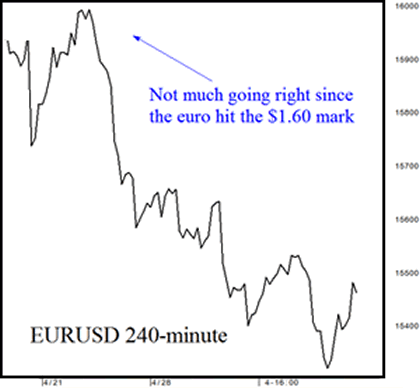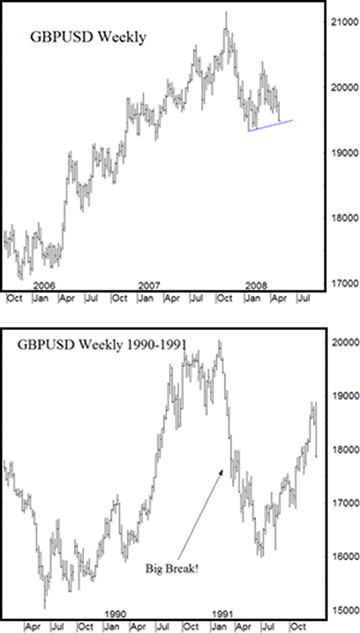US Dollar Bottoming Against Major Currencies?
Currencies / US Dollar May 11, 2008 - 12:19 AM GMT The dollar is gripping tightly to its two-week rally even though the fundamentals have changed very little. So what's behind the market's sentiment shift?
The dollar is gripping tightly to its two-week rally even though the fundamentals have changed very little. So what's behind the market's sentiment shift?
Less-dovish rhetoric from the Fed? That could be part of it. After the FOMC meeting last Wednesday, the Fed is now expected to stop cutting rates for the foreseeable future.
The latest economic news could also be lending a hand to the buck's strength. For example, last Friday's U.S. jobs report suggested the labor market may be entering recovery mode.
Still, the dollar's about-face started before either of those events. And that's why I attribute its recent rally to something else, something that's been mostly swept under the rug.
I'm talking about the G7 meeting that went down near the beginning of April. It may not have been given sufficient credit by the market at the time, but I think the rendezvous of finance ministers has had a big impact on the way many currencies have been behaving lately.
Bottom line: The dollar perma-bears are no longer convinced that the world's finance ministers are okay with a falling U.S. dollar. And they're readjusting their positions accordingly. In fact ...
Many of the Major Currencies Have Been Shaken Up As a Result of the G7 Meeting!
You know how it goes when a group of high ranking officials gets together to talk about the economy — they try not to alter their post-meeting statements too much for fear the markets may read too deeply into it.
And initially it looked as though they had succeeded in saying very little. The dollar was heading right back to its corner in the doghouse.
But then traders started to dissect the meeting a little more. And they became more concerned that maybe the dollar needs to strengthen and that maybe there's not much downside left ... if any at all!
What was once a sure-fire, one-way bet on dollar weakness is turning into a run-of-the-mill battle between the bulls and the bears. Yeah, I know, dollar bulls — it's hard to fathom!
But look at what's happening ...

The euro has topped out at $1.60. This was one of a few key barriers left on euro bulls' radar screens. It hit the mark once (shortly after the April G7 meeting, I might add!) and has been sliding ever since. Failure at this level has undoubtedly been a key driver behind the dollar rally.
European Central Bank interest rates have also topped out. Just this week, the ECB chose to leave rates at 4% ... again. And while they seem pretty adamant about winning the inflation battle, Euro area growth is too wishy-washy for them to consider pushing interest rates higher.
Meanwhile ...
The British pound has been in a constant struggle to find buyers. And even though it's not dropping nearly as quickly as the fundamentals might suggest, the dollar is benefiting.
 The Bank of England also decided to leave interest rates unchanged this week. But it's a good bet that the BOE has a couple interest rate cuts left to dish out this year.
The Bank of England also decided to leave interest rates unchanged this week. But it's a good bet that the BOE has a couple interest rate cuts left to dish out this year.
And that means the pound could have substantial downside ahead. The following pair of charts tells the story:
The chart on the top shows the pound sitting on the ledge. The chart on the bottom shows just how quickly it could fall from that ledge.
Keep in mind, however, there has been quite a contingent buying up the euro against the pound. This explains the seemingly unordinary days when the euro is down substantially and both the dollar AND the pound are showing strength. Suffice it to say the market has a way of working itself out.
Lastly ...
The commodity dollars are in turmoil. The skies above the Canadian dollar are slowly clearing up. Much of the disappointment the U.S. dollar has had to endure has pressured the Canadian dollar too, despite that country's relatively steady economy. But as the buck wiggles free of pressure, so too does the Loonie.
And after shaking loose the Canadian dollar, the Australian and New Zealand dollars have remained attached at the hip for quite some time. Rarely have we seen diverging price action between the two. Earlier in the week, however, was one of those rare examples.
What happened? An Aussie-positive economic report buoyed the Australian dollar. Normally the New Zealand dollar would follow the Aussie. But this time it sunk lower.
What's it mean? Further instances of divergence could indicate traders are growing more selective in their dollar-bashing.
What You Can Learn from All This Action ...
You can no longer just buy any ol' currency and simultaneously sell the dollar. It just isn't working like that anymore. Traders are finally facing up to the currency market imbalances that they previously shied away from.
If you've been jumping in against the dollar with reckless abandon, you may want to think twice about your trading decisions.
If you've slowly and steadily worked yourself away from the perma-bear camp, then I think you're in a good spot. You won't be surprised when this dollar rally lasts.
Best wishes,
Jack
This investment news is brought to you by Money and Markets . Money and Markets is a free daily investment newsletter from Martin D. Weiss and Weiss Research analysts offering the latest investing news and financial insights for the stock market, including tips and advice on investing in gold, energy and oil. Dr. Weiss is a leader in the fields of investing, interest rates, financial safety and economic forecasting. To view archives or subscribe, visit http://www.moneyandmarkets.com .
Money and Markets Archive |
© 2005-2022 http://www.MarketOracle.co.uk - The Market Oracle is a FREE Daily Financial Markets Analysis & Forecasting online publication.



